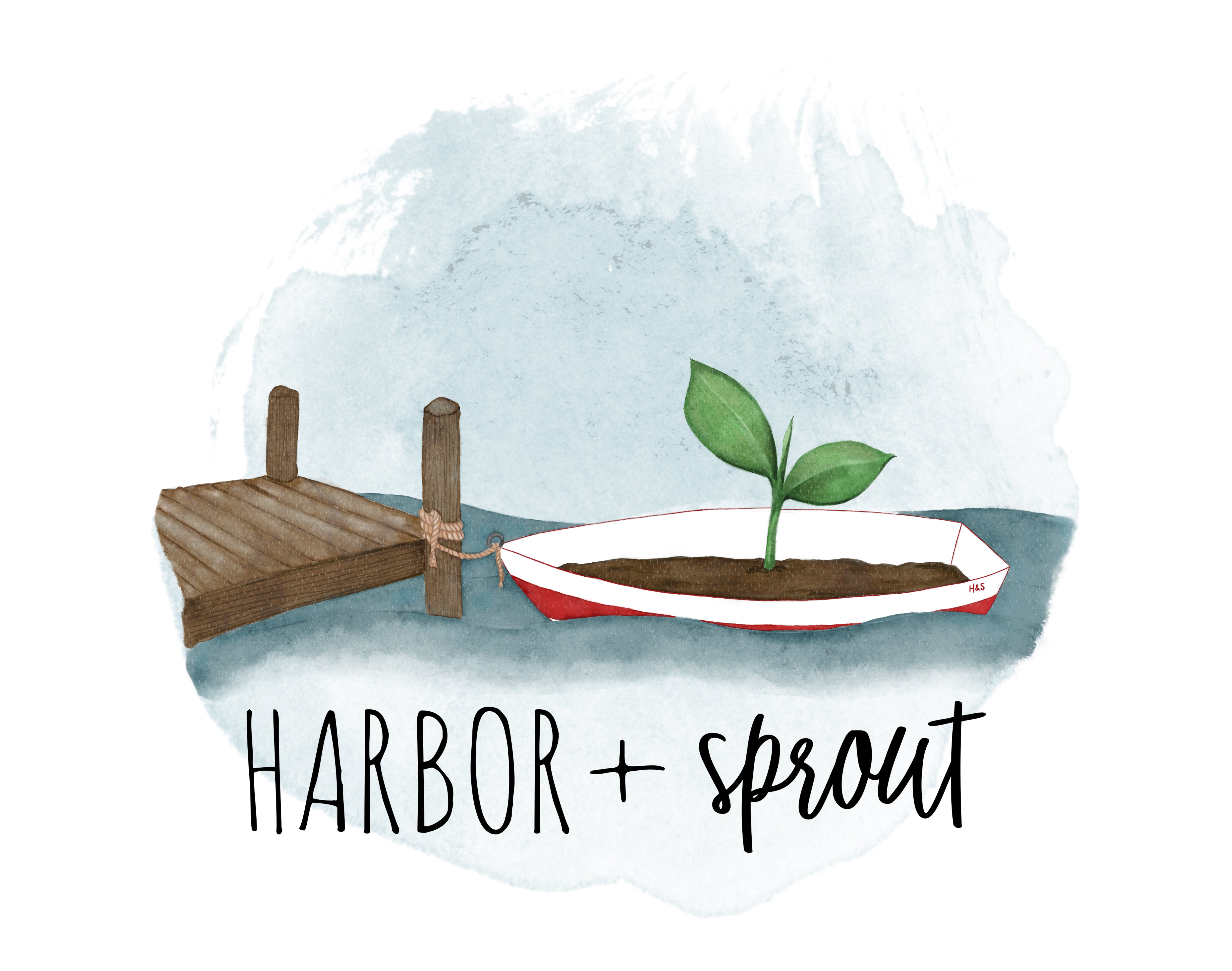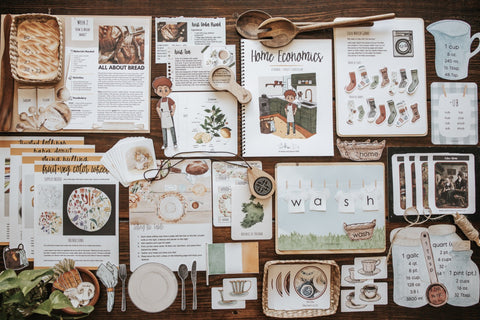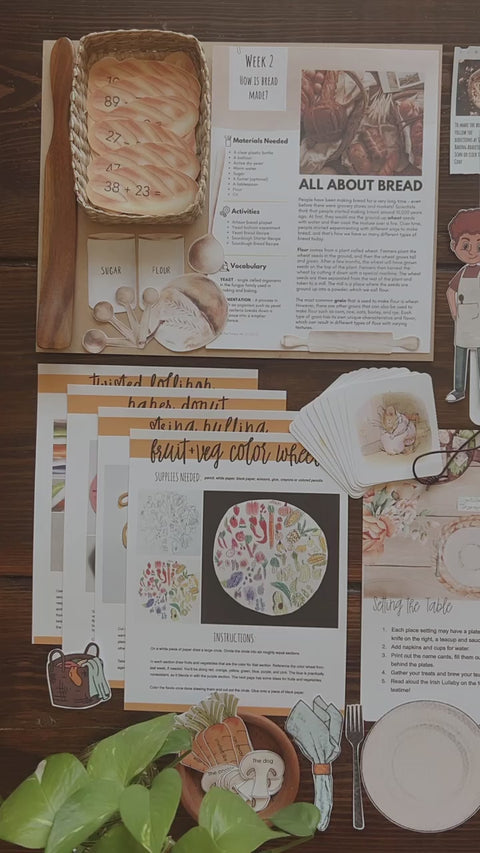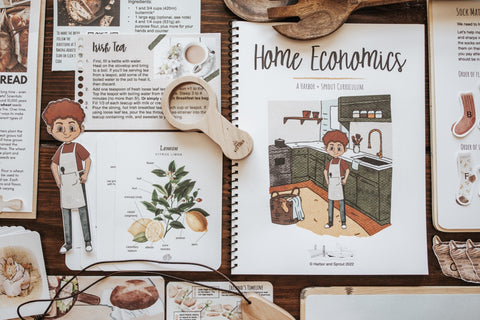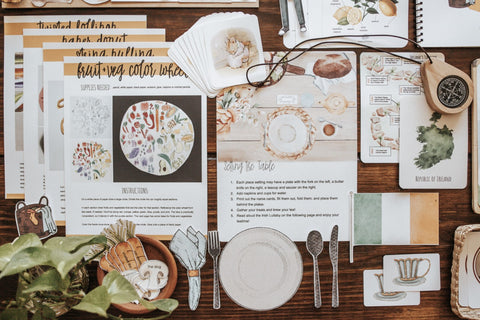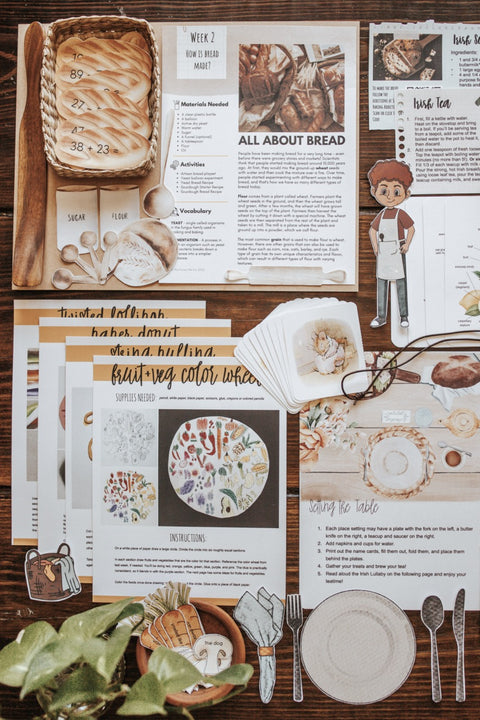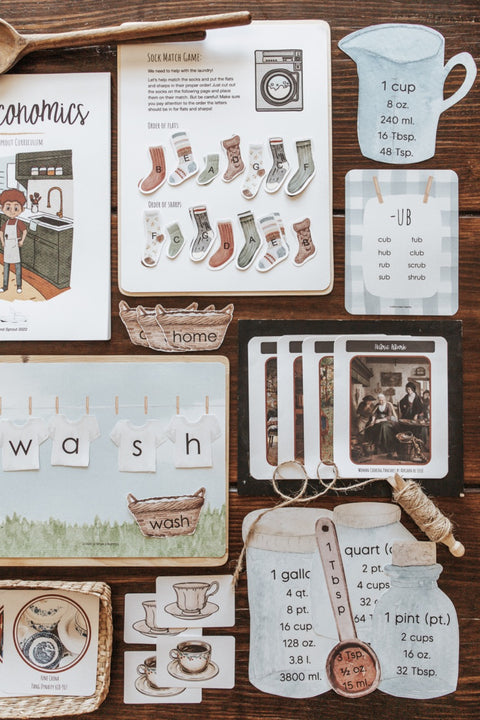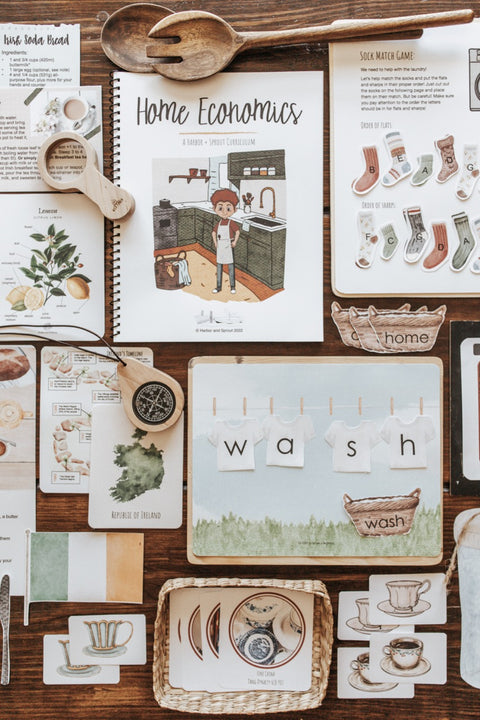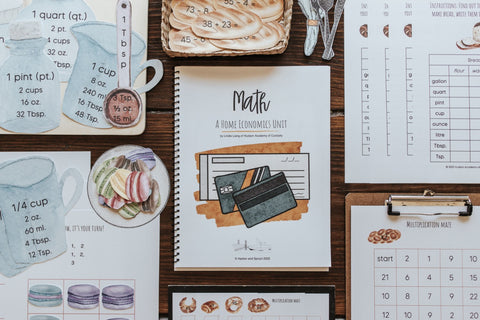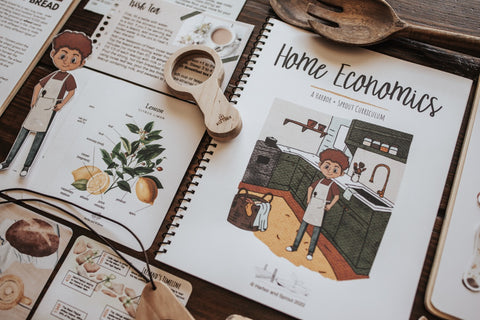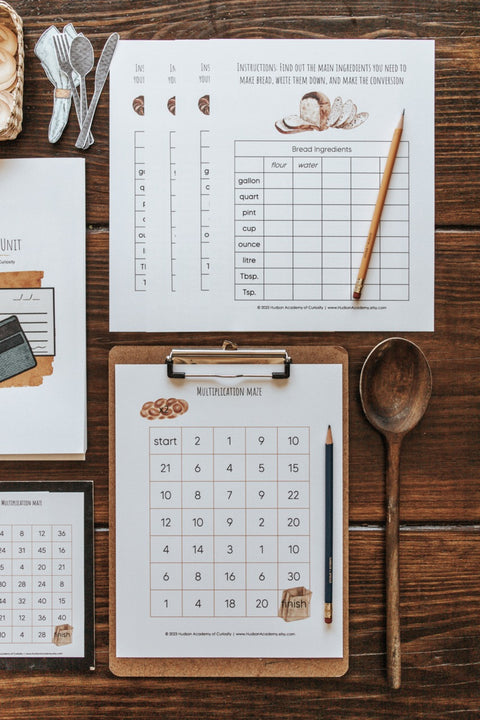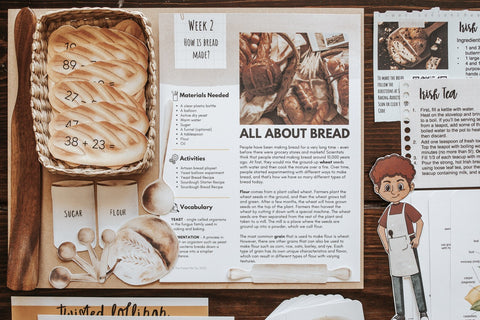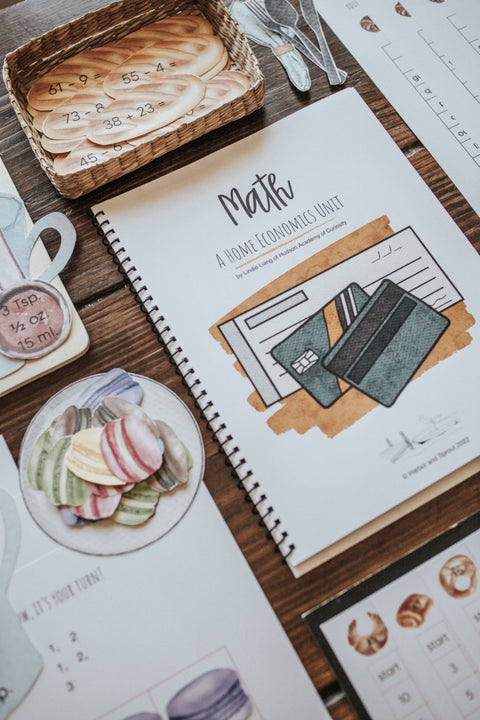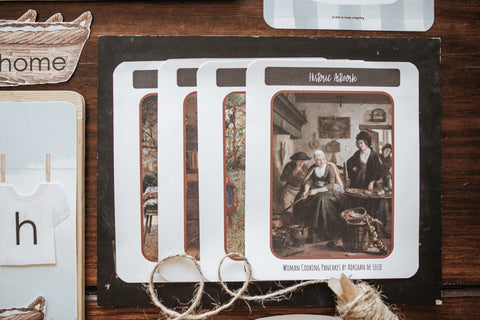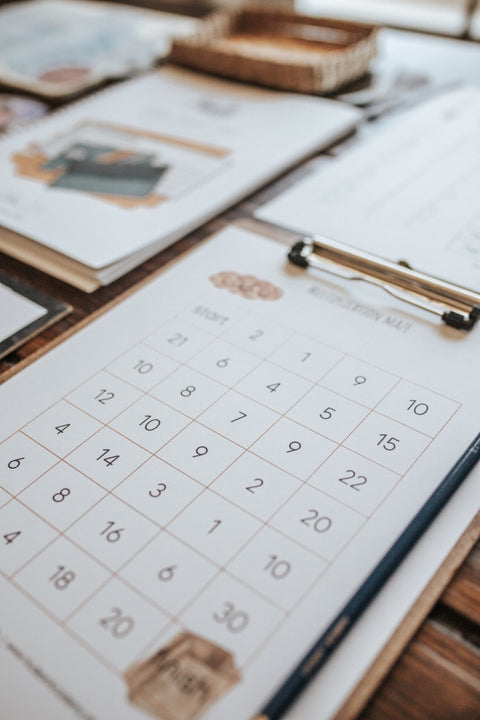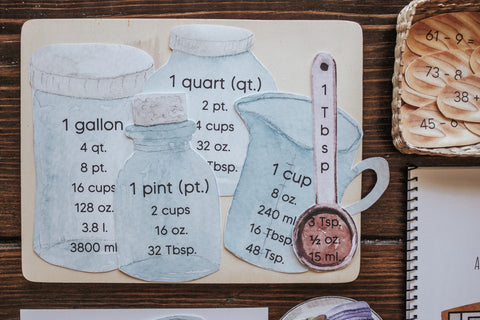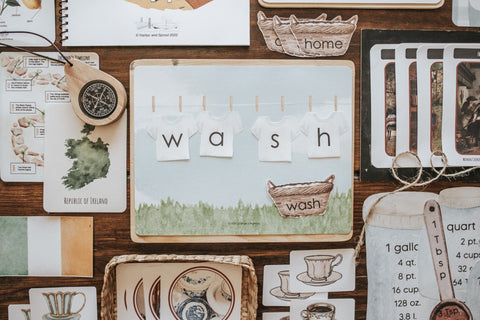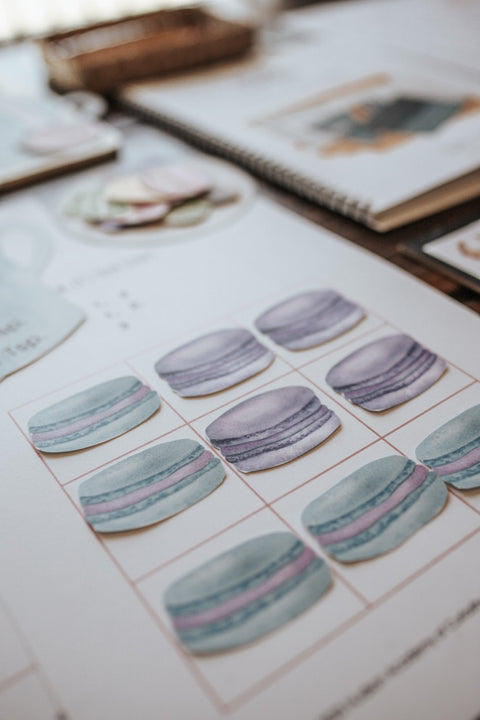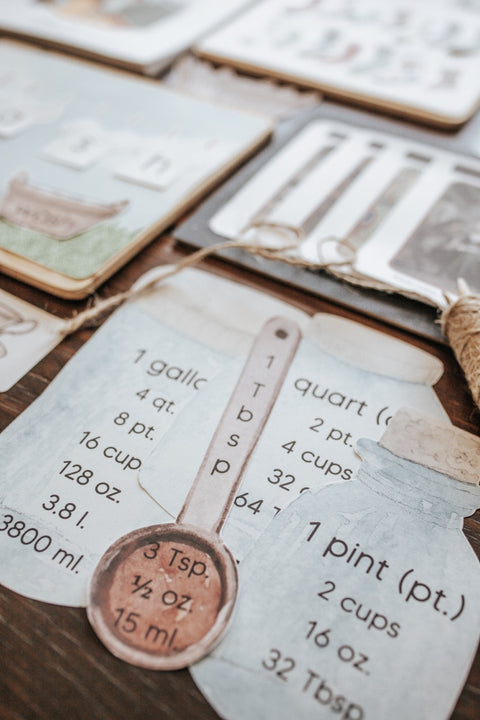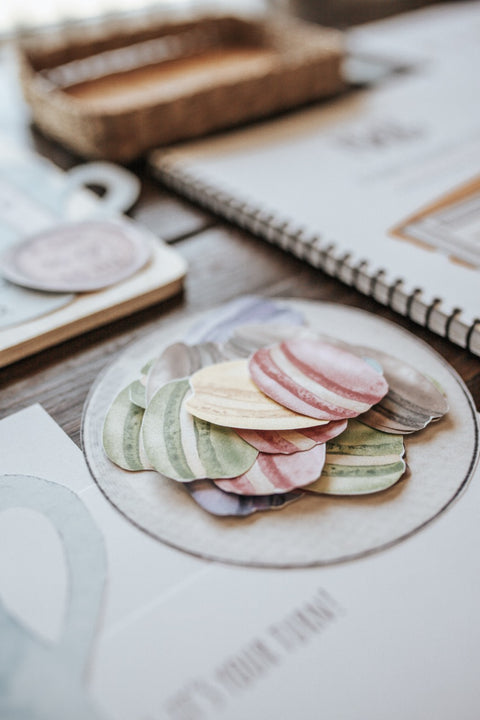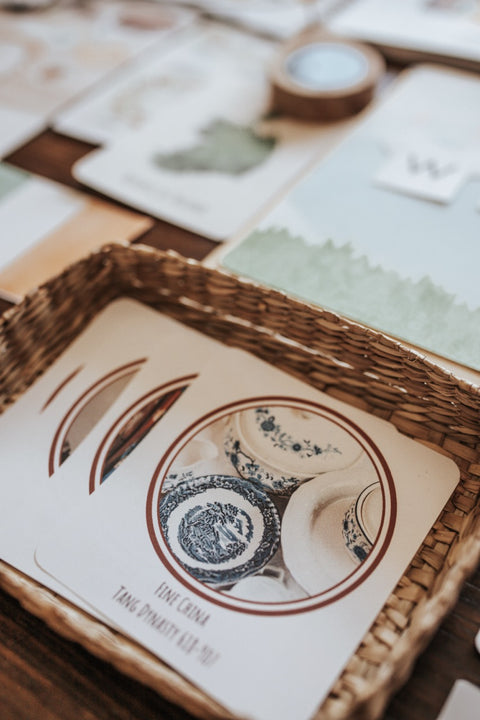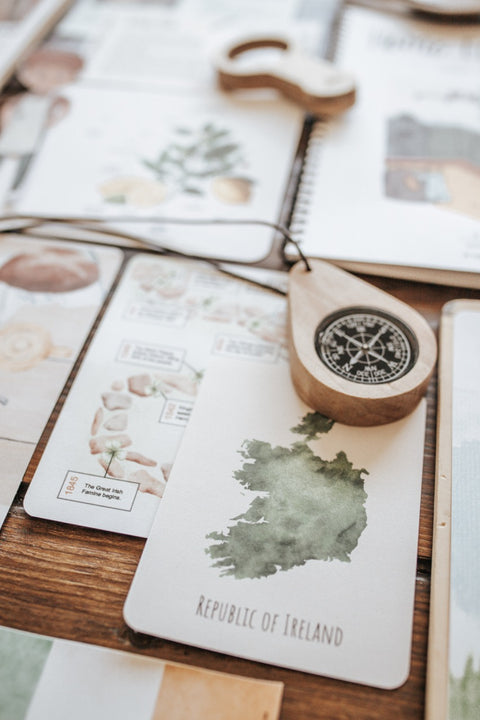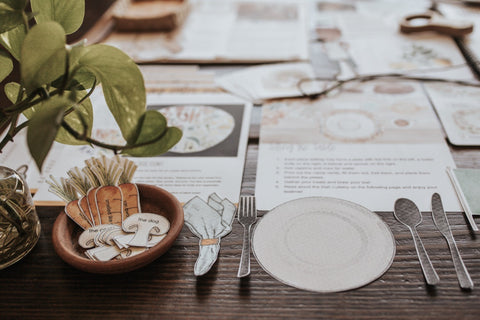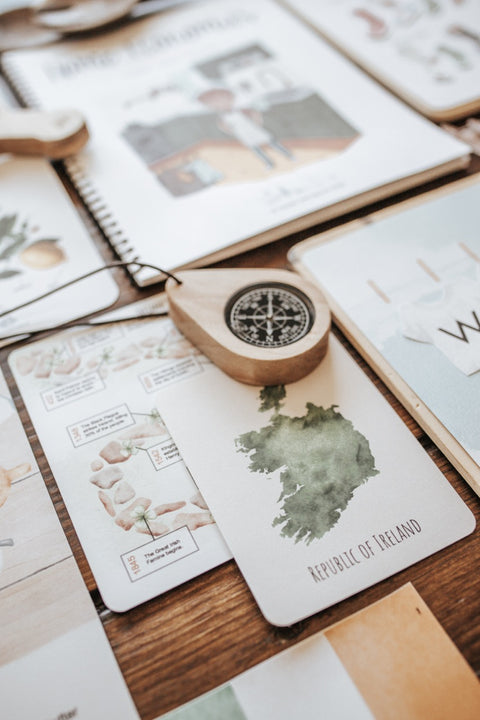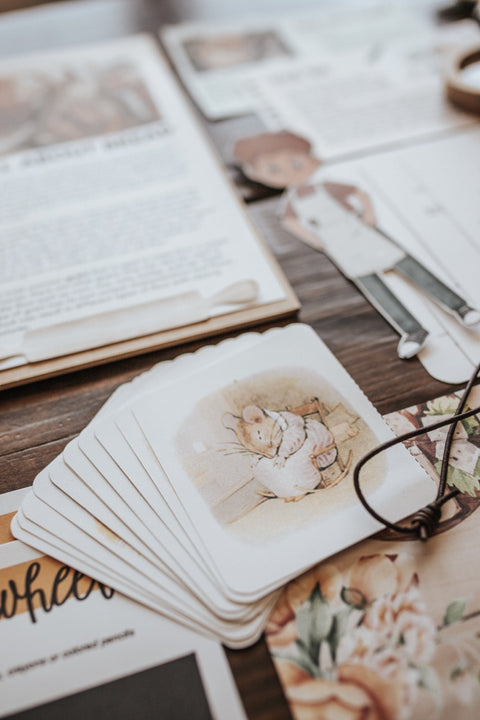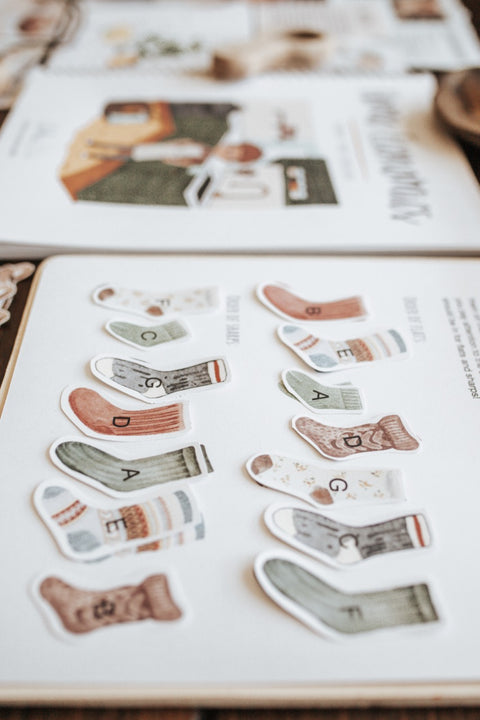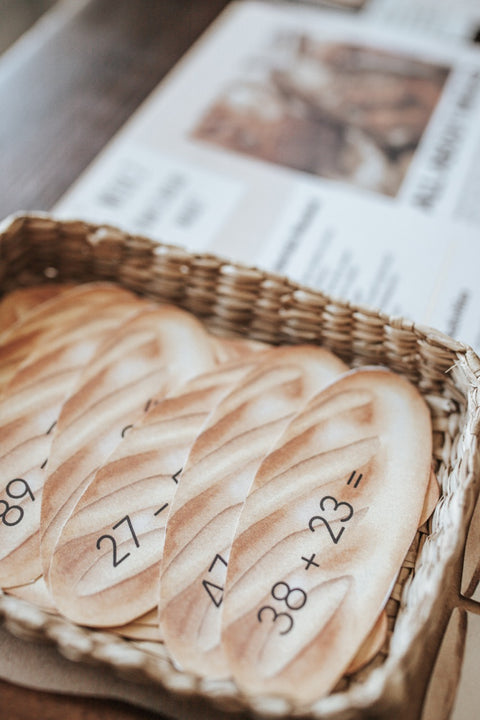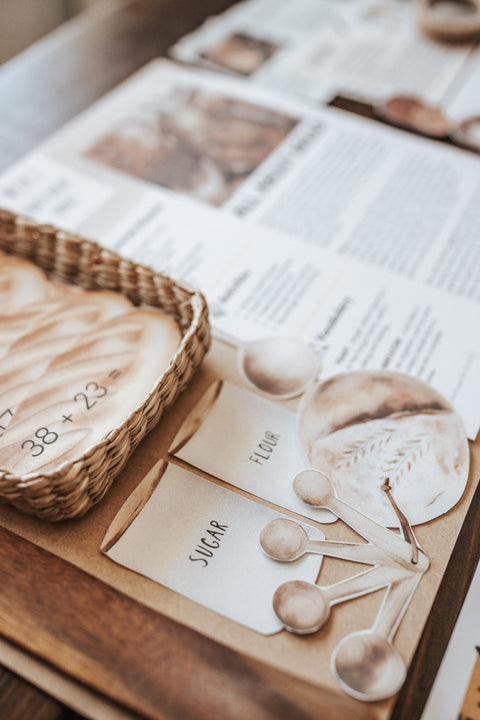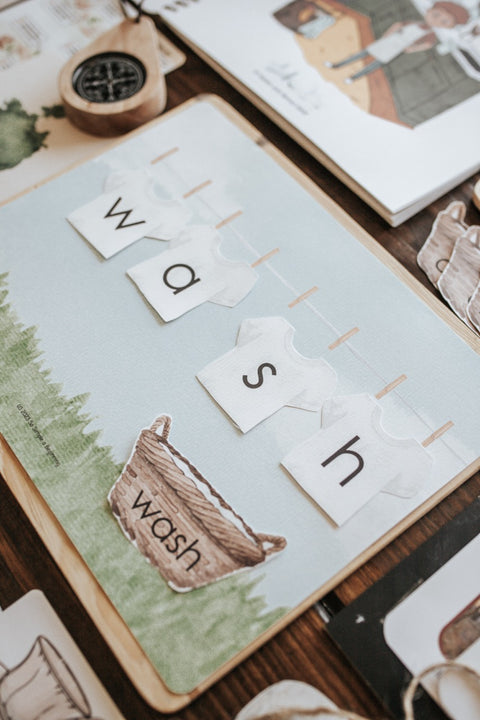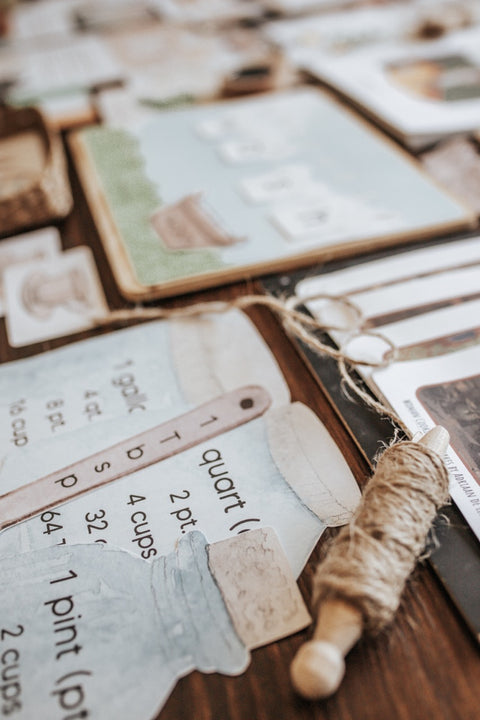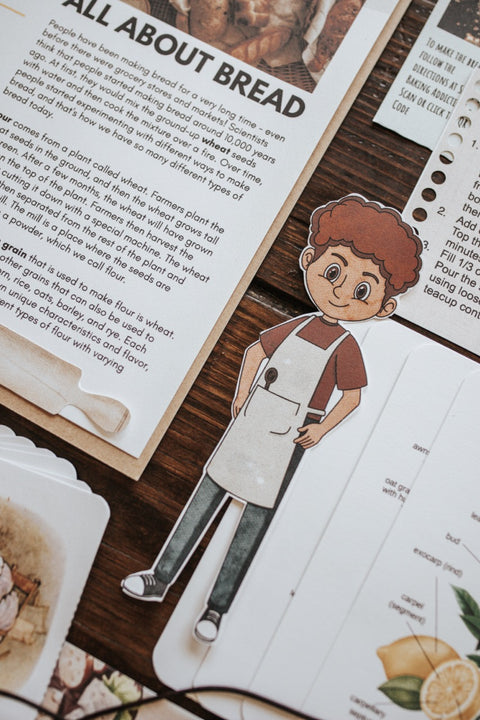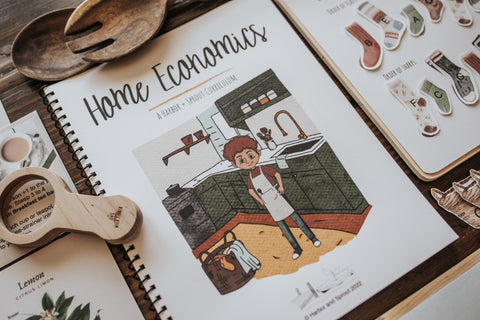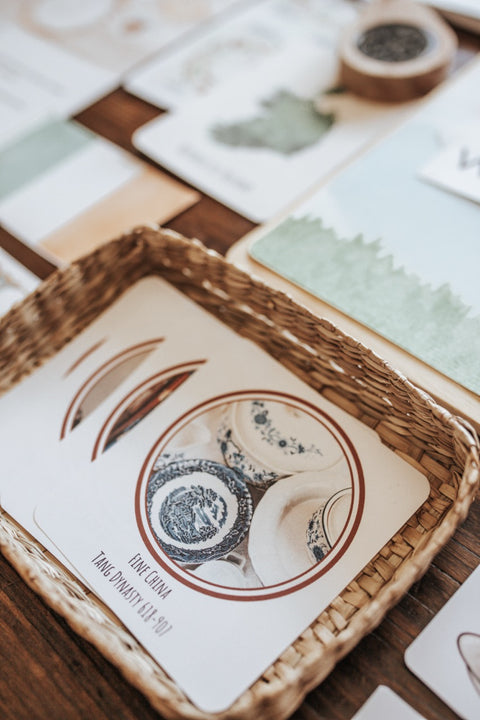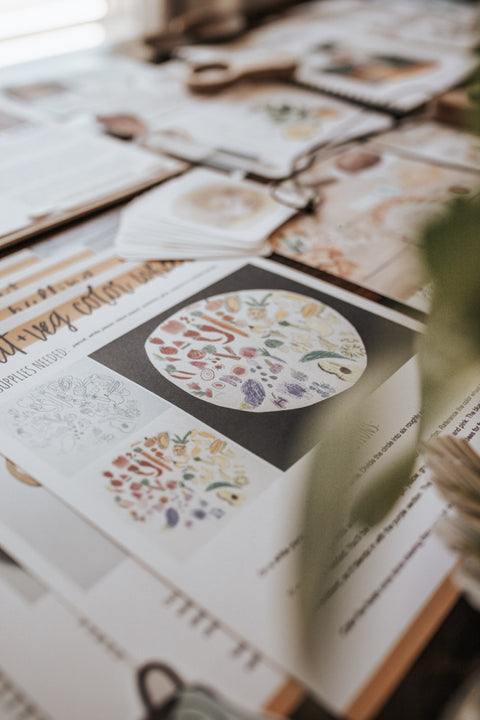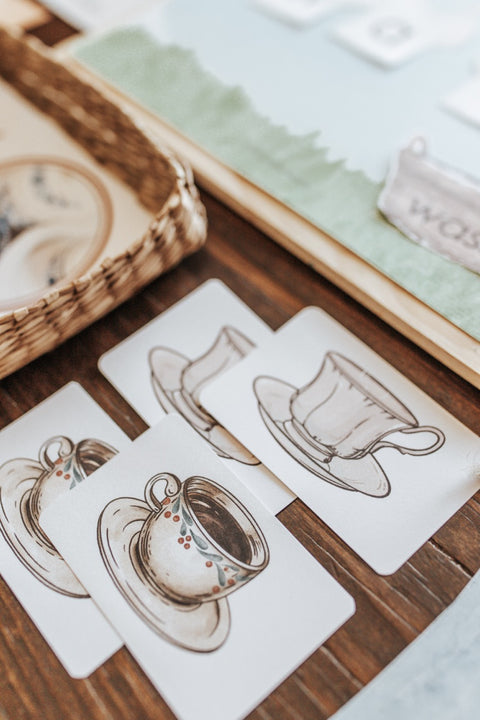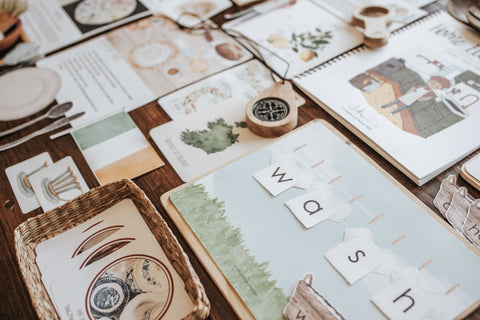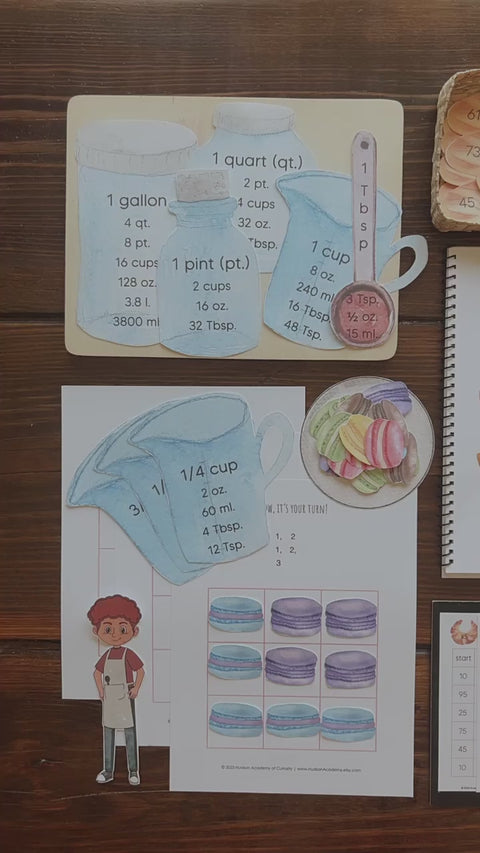Harbor and Sprout
Home Economics Patchwork Study
Welcome to the Harbor + Sprout Home Economics Patchwork Study, the April 2023 release of our elementary level homeschool unit study curriculum. This unit study features 4 weeks of lesson plans and materials covering all 9 of our core subjects and a playful supplemental section of thematic activities. This unit study is meant for use by children ages 3-12.
CONTENT:
Handbook
Daily, weekly, and monthly planning pages
Book list including stories, poems, and field guides with recommended ages, subject correspondence, and brief summaries for each title
Lesson plans for 4 levels of learning
Family read aloud with discussion guide and recipe
Character kit- new monthly character illustrated by Stephanie Groves to act as your guide through the unit
Science
Week 1: What are the Major Food Groups?- Explore different groups used to classify food. Discuss how to use your five senses to investigate food. Print off and play with the five food groups play set. Complete the color and trace activity. Go on a food groups scavenger hunt. Participate in a blind food test.
Week 2: How is Bread Made?- Learn what ingredients are used in bread. Discover what makes bread rise. Explore what yeast is. Print off and play with the artisan bread playset. Conduct an experiment to fill a balloon with air using yeast! Bake yeast bread. Make a sourdough starter and then bake sourdough bread.
Week 3: What are Collids and Emulsions?- Discover the difference between a colloid and an emulsion. Learn how to add necessary fats and oils to your diet. Churn your own butter. Whip your own whipped cream! Make agar-agar-- a dairy-free colloid. Mix together your own salad dressing.
Week 4: Who can you Cook with Heat and Cold?- Study the difference between an exothermic and endothermic reaction. Learn different ways that exothermic and endothermic reactions are used in cooking. Color the coloring page. Make your own ice cream! Conduct a hot ice experiment.
Nature Study
Week 1: Green Cleaning- Explore what 'green cleaners' have in common. Learn what gives vinegar, baking soda, and citrus fruit their natural cleaning powers! Study and dissect a lemon. Make lemon spray and design a label for your new household cleaning brand. Conduct an experiment with baking soda to identify acids and bases.
Week 2: Natural Ant Control- Discover how to identify ants and the three main reasons they enter our homes. Follow our natural tips for discouraging ant invasions and create a weekly chore wheel to keep on top of our ant deterrent tasks. Make your own peppermint ant repellent. Set up an ant trail study and observe their communication.
Week 3: Aromatherapy- Learn how essential oils are distilled from plant parts. Follow the path of a lavender scent molecule through our bodies to discover how aromatherapy works. Explore the health benefits of using lavender in our natural living routines. Make your own lavender sachet. Create nature-inspired clay diffuser disks to hang in your home.
Week 4: Health and Hygiene- Explore where Epsom salts come from and its health benefits, then make our own Epsom salts bath bombs! Grow crystals to explore how Epsom salts and table salts differ. Learn about the oat plant and the different types of oats we see at the market. Explore how we can use oats' anti-inflammatory and moisture-giving powers in our natural living routines, then make our own oat baths!
Language Arts
Week 1: Homemaking Words- Learn about the -ub word family. Study homemaking vocabulary. Choose a word to focus on and describe. Choose homemaking words to learn to spell. Use the laundry letters to help you practice spelling vocabulary words. Choose your favorite homemaking word and research its origin. Color the coloring page.
Week 2: The Tale of Mrs. Tittlemouse- Read or listen to the story "The Tale of Mrs. Tittlemouse." Enjoy a story teatime as you listen to the poem. Make a tiny broom. Print out the story cards and see if you can put the story in the correct order. Summarize the story in your own art or words. Complete the "T is for Tidy" coloring page. Answer the story study questions.
Week 3: Subject and Predicate- Discover the definition of subject and predicate. Explore how to identify the subject and predicate in a sentence. Watch the Schoolhouse Rock video "The Tale of Mr. Morton." Review nouns, pronouns, and verbs. Create sentence soup to practice subject and predicate. Complete the subject and predicate worksheets.
Week 4: CVC Words- Learn about CVC words. Practice building CVC words with letter dice. Play a To Do List game with the CVC letter dice. Play minute to win it to see how many CVC words you can roll in one minute. Finally, challenge yourself to roll and write CVC words.
Writing
Week 1: All About You- Write about the person you know best: you! Complete the "All About Me" worksheet. Find pictures of yourself and your family and create a personal scrapbook. Conduct a personal interview with a parent about the day you were born. Reflect on what you've written about this week and write about what makes you special.
Week 2: Journal Writing- Learn about the benefits of keeping a journal. For an entire week, write in your journal every day. Choose from per-written prompts, or write about whatever you'd like!
Week 3: Write About the Past- Conduct an interview with an older family member or family friend. Learn about what life was like for them when they were your age. Create a picture scrapbook with photos of the person you interviewed. Complete the interview follow-up worksheet. Finally, copy down a family recipe and then, as an added bonus, cook that recipe!
Week 4: Look to the Future- Write about what you think the world will be like when you're 100 years old. Reflect on your life goals, then write a letter to your future self describing what you think you'll be doing in 25 years. Create a time capsule to be opened in 25 years. Decorate the time capsule. Fill out the "Time Capsule Worksheet" to include in your time capsule.
History
Week 1: Work Schedule- Consider what you already know about entomologists and fill out the "Who is a Home Economist" worksheet. Study the history of home economics. Read about how housework schedules have been beneficial to homemakers throughout history. Create your own housework schedule. Complete a historical figure report.
Week 2: Aprons- Discover what an apron is, why it was invented, and what it is used for. Design your own apron. Match the aprons. Learn about flour sack aprons.
Week 3: Fine China- Learn about the dishes known as fine china. Find out where fine china originated and how it got its name. Make your own friendship tea. Design your own fine china tea cup and plate. Match the tea cups. Complete a historical figure report.
Week 4: Cookbooks- Explore how cookbooks have developed and been used throughout history. Go on a cookbook scavenger hunt! Make a list of some of your favorite recipes. Complete a historical figure report.
Geography
Week 1: Republic of Ireland- Discover some interesting facts about Ireland including its climate, national tree, national animal, and national flower. Color the Irish flag. Complete the color by shape activity. Test your knowledge of Ireland with the included trivia cards.
Week 2: Maps- Trace the continent of Europe and the country of Ireland. Locate Europe and Ireland on the map. Can you also find any other countries, continents, or oceans that you recognize? Cut out the labels and use them to label the map of Ireland. Label the significant geographic areas of Ireland from memory.
Week 3: Ireland History and Culture- Discover events from Irish history. Learn about language, religion, and cuisine. Explore the historic timeline of Ireland. Complete the "Ireland's Timeline" worksheet. Complete the copy work for the Irish proverb.
Week 4: A Cozy Irish Tea Time- Learn Irish traditions surrounding drinking tea. Make your own Irish tea and Irish soda bread. Set a fancy table for your tea, and use special place cards. Learn an Irish lullaby.
Music
Week 1: Creating Atmosphere with Major and Minor- Explore the concept of atmosphere in music. Learn about major and minor keys. Study how major and minor scales are structured. Play a build-a-chord game.
Week 2: Flats and Sharps- Discover what a flat is and what a sharp is. Find out the order in which flats and sharps are written in key signatures. Play the sock match game to practice the order of flats and sharps.
Week 3: Circle of Fifths- Learn how to use the circle of fifths to organize different key signatures. Use the circle of fifths page to answer the questions on the "Check it Out" page. Play a circle of fifths game.
Week 4: Irish Instruments- Explore the Celtic harp and the harmonica. Make your own harmonica. Color the coloring page.
Art
Week 1: Quilting- Discover artwork by the artist Faith Ringgold. Study the art element of lines. Fill in the "L is for Line" to look like a quilt. Create your own quilt block. Color the quilt. Complete a story quilt. Design your own Gee's Bend quilt. Construct a quilted hot air balloon. Complete an art study. Critique your own art.
Week 2: Baking- Explore artwork created Wayne Thiebaud. Discover the art element of form. Decorate the "F is for Form." Design your own cardboard slice of cake. Color the cake coloring page. Use color theory to create a twisted lollipop. Construct your own paper donut. Color the donut coloring page. Create a 3D ice cream cone. Color the quotation page. Complete an art study. Critique your own art.
Week 3: Cooking- Study the artist Clementine Hunter. Explore the art element of color. Fill in the "C is for Color." Design your own alphabet soup. Color the alphabet coloring page. Paint your bread for a colorful, artistic snack. Construct a fruit and vegetable color wheel. Create your own salt dough pie crust. Color the lattice pie coloring page. Complete an art study. Critique your own art.
Week 4: Sewing- Discover artwork created by the artist Mary Cassatt. Study the art element of shape. Use your creativity to fill in the "S is for Shape." Construct your own button tree. Decorate the buttons. Use string and paint to create art. Color the bedroom coloring page. Design your own embroidered sketch. Sew your own special friend. Complete the maze. Complete an art study. Critique your own art.
Math
Week 1: Kitchen Conversions- Study different measurements. Explore how these forms of measurement can be converted to other forms of measurement. Practice converting ingredients to different measurements.
Week 2: Calculation Practice- Practice solving different equations. Equations vary in difficulty and include addition, subtraction, multiplication, and division. Week 3: Multiplication Maze- Solve the multiplication mazes. Create your own maze.
Week 4: Pixel Programming & Cake Number Connections- Choose the activity that is most appropriate to your learning level. Older learners: discover the basics of programming and practice introductory programming. Younger learners: solve the number connection puzzles.
Supplement
Building CVC Words
Coloring Pages
Home Economics I Spy and Count
Missing Letter Clip Cards
Home Economics Silhouette Match
Home Economics Tic Tac Toe
Home Economics Tracing Words
Verb, Noun, and Adjective Sort
Bilingual Clothing 3-Part Cards
Bilingual Number Laundry Line
Home Economics Word Search
Home Economics I Spy Game
This unit is delivered as a downloadable zip file. Enjoy your Home Economics adventure!
